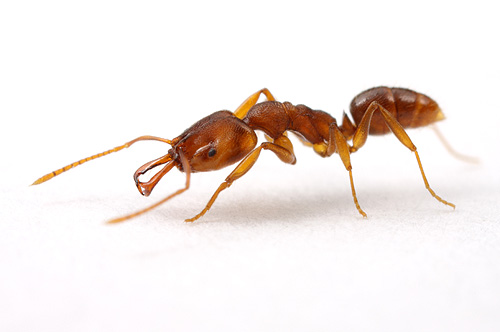Anochetus mayri is an ant most North American myrmecologists will not have encountered in the field. This toothy exotic is a small brown insect, less than half a centimeter long, known in the United States only from scattered locations in suburban Florida. I photographed one this summer on a collecting trip to West Palm Beach.
Anochetus mayri illustrates a couple recurring themes in myrmecology.Â
First is just how inadequate our taxonomic understanding of ant species remains.  While identifying this ant in West Palm Beach is easy enough- A. mayri is the only Anochetus found in our country- sorting out where it came from is another matter. In Central and South America, several ill-defined and unnamed biological species seem to fit under the broad A. mayri umbrella. Until someone has the time to properly sort through the accumulated museum specimens, we'll be left guessing as to where our little interlopers came from, what they did in their native range, and if they've started doing anything differently that facilitates their spread. If the history of insect taxonomy is any guide, this study may be decades away. Taxonomic problems well outnumber taxonomists.
Second is that Florida is an epicenter of biological invasion. The mild climate and heavy development create a perfect set of conditions for many pesty tropical species. Anochetus mayri is just one of many exotics that has gained a toehold on the peninsula.
Mark Deyrup, who wrote a short paper on the advent of A. mayri, comments:
The trajectory of A. mayri in Florida ecosystems is impossible to predict at this point. It is widespread in the Caribbean and in Central and South America, but, in my limited experience, it is not a dominant species. It cannot be considered a major threat to native species in Florida as long as the Florida population is confined to urban and suburban habitats that are already somewhat disturbed and perfused with many other exotics.

In the field, Anochetus mayri is an inconspicuous, cryptic insect that blends into its habitat. It may not be easy to find even where it is common.
Sources:
Deyrup, M. 2002. The exotic ant Anochetus mayri in Florida. Florida Entomologist 85: 658-659.
Longino, J. T. 1998. Anochetus mayri Emery 1884. Species page in the ants of Costa Rica, http://academic.evergreen.edu/projects/ants/genera/Anochetus/SPECIES/mayri/mayri.html
Photo details: Canon MP-E 65mm 1-5x macro lens on a Canon EOS 50D
ISO 100, f/13, 1/250 sec, diffused twin flash


Hey, do these ants jump? And I don't mean by snapping their mandibles. (It's a serious and a non-tricky question).
I'd be very surprised if they could. These are small, slow-moving litter ants, appearing in the field more like Strumigenys than Odontomachus.
We have a bunch of Anochetus species in the Philippines. When you put a live Anochetus in a vial of alcohol, you can clearly hear the snapping of the mandibles. We have to be careful to hold it with forceps until it dies, otherwise it'll just chew up any other specimens in the vial. With such power behind the bite, I wouldn't be surprised if they employ a similar "jumping technique" that Odontomachus uses.
What no cat?
It's a handsome ant (being highly allergic to ant stings, I like to appreciate them from a distance--or better yet, through photos!). These are great captures.
On a different yet similar line of frustration with the lack of taxonomic understanding, I ran into a similar issue in Texas while trying to identify a harvestman. The interesting thing is we only have 18 known harvestman species in the state, yet so little study has been done on them that it's pretty much impossible to identify one (outside of the three endangered species, that is). I'm nowhere near as scientifically versed as others and am appreciative of the frighteningly vast insect and arachnid landscape, but I have to admit I beat my head against the wall sometimes when something terribly common or exceptionally unique is labeled as "unidentified" because we just don't know enough about it. This is why seeing the entomology class blog has excited me: these "kids" seem really intoxicated by the challenges and the discovery, so there's hope that we'll keep digging for that elusive understanding.
heh.
Great photos - I've placed a link to this post from the Evolution Scetion of the Faster Times magazine.
http://thefastertimes.com/evolution/
Meow!